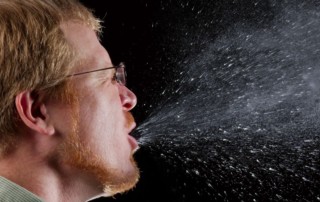COVID-19
UNIC Coronavirus Health and Research Portal
On Coughing and Airborne Droplet Transmission to Humans
Talib Dbouk and Dimitris Drikakis
University of Nicosia, Nicosia, Cyprus
The recent COVID-19 pandemic prompted the need for deeper understanding of the transport of fluids and droplets emanating from our respiratory tracts when we cough, sneeze, speak or breathe. The droplets transport will influence the spread of coronavirus and determine the implementation of guidelines about social distancing, mask wearing, crowded gatherings, as well as everyday practices of social behaviour in private, public and business environments.
The results of our research showed that in open spaces, airborne droplets carriers can travel significantly further than the 2 meters recommended distance due to the wind speed. The issues arising from the past and recent pandemic require a holistic approach to elucidate the open scientific questions and address the practical challenges. Such an approach would require closer interaction between bio-medicine, engineering fluid physics, and social sciences.
Figure 1
Saliva droplet cloud kinematics show the diameter of the droplets resulting from a human cough. Larger droplets settle more rapidly than smaller ones due to gravitational forces. The wind speed is approximately 0 km/h. The total mass of ejected saliva is 7.7 mg, with 1008 total number of droplets. The environment is at ambient temperature, pressure, and relative humidity of 20 oC, 1 atm, and 50%, respectively, with the ground temperature at 15 oC. The droplets in the figure have been scaled up for visualisation purposes.
Figure 2
A human cough: saliva droplet’s disease-carrier particles emanating from coughing do not travel more than 2 m in space at approximately zero wind speed. The environment was considered to be at ambient temperature, pressure, and relative humidity of 20 oC, 1 atm and 50% with the ground temperature at 15 oC.
Figure 3
Saliva droplets can travel large distances, depending on environmental conditions such as wind speed, temperature, pressure and humidity. Wind shown blowing left to right at speeds of 4 km/h (top) and 15 km/h (bottom) can transport saliva droplets up to 6 meters. The droplets in the figure have been scaled up for visualisation purposes.
What Does This Mean?
- In open spaces, airborne droplet carriers can travel significantly further than the 2m recommended distance depending on the wind speed and the environmental conditions. The above is an important finding and Citizens and policy-makers should be aware of it.
- If a person is in the path of the virus cloud, the risk of infection will, most likely, depend on the dosage and time of exposure. Therefore, it is crucial to better understand which scenarios may allow the transmission at longer distances. The present study contributes to advancing the above understanding.
- The dosage and time needed for an infection is still under study and may vary from one person to another. Further research and closer interaction between bio-medicine and engineering fluid physics are necessary to understand the conditions under which patients are being infected.
Non-Technical Summary
The recent COVID-19 pandemic prompted the need for deeper understanding of the transport of fluids and droplets emanating from our respiratory tracts when we cough, sneeze, speak or breathe. The droplets transport will influence the spread of coronavirus and determine the implementation of guidelines about social distancing, mask wearing, crowded gatherings, as well as everyday practices of social behaviour in private, public and business environments.
When sneezing or coughing, larger droplets are formed by saliva, and smaller droplets by mucous coating of the lungs and vocal cords. The smaller droplets are often invisible to the naked eye. Past research has shown that most respiratory droplets do not travel independently on their trajectories. Instead, droplets in a continuum of sizes are trapped and carried forward within a moist, warm, turbulent cloud of air. Although the mechanisms of virus transmission are still under debate, it is widely accepted that aerosol or respiratory droplet transmission is the critical factor for the rapid spread and continued circulation of viruses in humans.
We think that it is likely the dosage and time of exposure which determine whether or not infection will finally occur. Therefore, it is crucial to decide on the scenarios that will allow the transmission to longer distances. Our study aimed at advancing the understanding of the transfer of airborne particle carriers to humans through advanced coupling between droplets and fluid flow modeling and simulation.
The initial modeling configuration of the problem takes into account several parameters that can influence the simulation, including the wind speed in an open environment.
An accurate prediction of the transfer of airborne particle carriers to humans from a cough is governed by the following modeling considerations that must be taken into account:
- The saliva droplets initial size distribution at the onset of the coughing event.
- The human mouth-print of the cough.
- The period of the cough and its intensity (or initial saliva droplets speed).
- The numerical modeling approach to capture the complex varying space and time scales, e.g. both heat and mass transfer considerations, modeling of mass and phase changes due to droplets evaporation, coalescence, break up and turbulent dispersion in interaction with the bulk flow field.
The computational domain in the simulation is a grid in front of the coughing person . The analysis involved running partial differential equations on 1008 saliva droplets and solving approximately 3.7 million equations in total.
Our findings showed that, when a person coughs, the wind speed in an open space environment significantly influences the distance that airborne disease-carrier droplets travel.
- Without surrounding wind speed, the droplets will fall to the ground in a short distance from the person exhaling or coughing. The present analysis shows that the range may not exceed one meter (See Figure 2). A tiny number of particles may travel slightly further longer. Still, their trajectory beyond one meter will already be at a height significantly below half a meter dropping towards the ground. Thus, these droplets may not constitute a risk regarding facial contact of adults at this distance.
- At wind speeds from 4 to 15 km/h, we found that saliva droplets can travel to distances up to 6 meters with decreasing concentrations and liquid droplets size in the wind direction (see Figure 2). Our findings imply that depending on the environmental conditions, the 2 meters social distance may not suffice. Further research is required to quantify the influence of other parameters such as the environment relative humidity and temperature amongst others.
- The droplets cloud will affect both adults and children of different heights. Shorter adults and children could be at higher risk if they are located within the trajectory of falling droplets.
- At a lower wind speed, the droplet total mass reduction occurs more slowly compared to a higher speed, which may prolong the exposure of a human to the droplets if the subject is located within the droplets envelope.
Overall, the results showed that in open spaces, airborne droplets carriers can travel significantly further than the 2 meters recommended distance due to the wind speed. The issues arising from the past and recent pandemic require a holistic approach to elucidate the open scientific questions and address the practical challenges. Such an approach would require closer interaction between bio-medicine, engineering fluid physics, and social sciences.
Figure 1
Saliva droplet cloud kinematics show the diameter of the droplets resulting from a human cough. Larger droplets settle more rapidly than smaller ones due to gravitational forces. The wind speed is approximately 0 km/h. The total mass of ejected saliva is 7.7 mg, with 1008 total number of droplets. The environment is at ambient temperature, pressure, and relative humidity of 20 oC, 1 atm, and 50%, respectively, with the ground temperature at 15 oC. The droplets in the figure have been scaled up for visualisation purposes.
Figure 2
A human cough: saliva droplet’s disease-carrier particles emanating from coughing do not travel more than 2 m in space at approximately zero wind speed. The environment was considered to be at ambient temperature, pressure, and relative humidity of 20 oC, 1 atm and 50% with the ground temperature at 15 oC.
Figure 3
Saliva droplets can travel large distances, depending on environmental conditions such as wind speed, temperature, pressure and humidity. Wind shown blowing left to right at speeds of 4 km/h (top) and 15 km/h (bottom) can transport saliva droplets up to 6 meters. The droplets in the figure have been scaled up for visualisation purposes.
The University of Nicosia (UNIC)
About the University of Nicosia
The University of Nicosia (UNIC) is the largest university in Cyprus, and the largest university in southern Europe that teaches primarily in English, welcoming 12,000+ students from over 70 countries worldwide. The University of Nicosia is a comprehensive university with 6 schools, 20 departments and over 100 degree programs offered on-campus and online.
The University of Nicosia is best known in the fields of medicine, law, blockchain, accounting, education, forecasting and international relations and for a series of partnerships with other leading European universities. UNIC was most recently ranked #106 in its region by QS and #300 to #400 globally in the Times Higher Education Impact rankings.
To learn more about the University of Nicosia, please see: https://www.unic.ac.cy/
UNIC’s COVID-19 Response
University of Nicosia faculty across a variety of academic disciplines are actively engaged in research and analysis and serving in scientific / public policy roles supporting the global COVID-19 response.
For more information about the University of Nicosia’s work relating to COVID-19 including potential collaboration, please see: https://www.unic.ac.cy/coronavirus/
Contact Information
For more information about this study, please contact Prof Dimitris Drikakis at [email protected].
For more information on our COVID-19 related research in general, please contact UNIC at [email protected].
Press Coverage
Articles and press mentions in global media about the research.
Il vento leggero può far viaggiare il droplet di 6 metri: 1 metro di distanza forse non basta – Rassegna Stampa
Due ricercatori ciprioti dell'Università di Nicosia hanno determinato che un leggero vento compreso tra i 4 e i 15 chilometri orari (brezza) è sufficiente per far viaggiare fino a 6 metri le goccioline di saliva espulse dalla bocca. Ciò suggerisce che il distanziamento sociale di 1 o 2 metri potrebbe non essere sufficiente a proteggerci dall'infezione da coronavirus... Read more here: Rassegna Stampa:" Il vento leggero può far viaggiare il droplet di 6 metri: 1 metro di [...]
When is 6 feet not enough to avoid Covid-19 transmission? In light wind conditions
When is 6 feet not enough to avoid Covid-19 transmission? In light wind conditions Airborne transmission of viruses, like the virus causing COVID-19, is not well understood, but a good baseline for study is a deeper understanding of how particles travel through the air when people cough. In a paper published in Physics of Fluids, from AIP Publishing, Talib Dbouk and Dimitris Drikakis of University of Nicosia discovered that with even a slight breeze of 4 kph, saliva travels 18 [...]
2 metri di distanza non bastano a fermare la trasmissione del virus SARS-CoV-2
La trasmissione aerea del virus SARS-CoV-2, che causa l’attuale pandemia non è ben compresa. Gli ultimi studi si basano sulla comprensione di come le particelle possano viaggiare nell’aria quando le persone tossiscono o stranutiscono. In un articolo pubblicato su Physics of Fluids, i ricercatori Talib Dbouk e Dimitris Drikakis hanno scoperto che con una leggera brezza di 4 km/h permette alla saliva di viaggiare per circa 5,4864 metri in 5 secondi. Nell’ultima intervista del ricercatore Drikakis, afferma: “La nuvola di [...]
Study shows that six-feet social distancing may not be enough
Study shows that six-feet social distancing may not be enough Washington D.C: The current social distancing guideline of 6 feet maybe insufficient according to a recent study as saliva droplets can travel 18 feet in five seconds at low wind speeds. Airborne transmission of viruses, like the virus causing COVID-19, is not well understood, but a good baseline for the study is a deeper understanding of how particles travel through the air when people cough. In a paper published in [...]
Σταγονίδια σάλιου από ανθρώπινο βήχα μπορούν να μεταφερθούν πέρα από 2 μέτρα
Σταγονίδια σάλιου από ανθρώπινο βήχα μπορούν να μεταφερθούν πέρα από 2 μέτρα Σύμφωνα με άρθρο ερευνητών του Πανεπιστημίου Λευκωσίας στο επιστημονικό περιοδικό Physics of Fluids, οι τρέχουσες οδηγίες κοινωνικής απόστασης των 2 μέτρων μπορεί να είναι ανεπαρκείς, διότι ένας ήπιος βήχας σε συνδυασμό με χαμηλές ταχύτητες ανέμου 4-15 km/h είναι δυνατό να μεταφέρει σταγονίδια σιέλου σε απόσταση 6 μέτρων! Η επιστημονική γνώση για την αερομεταφερόμενη μετάδοση ιών όπως ο Sars-cov2, είναι ανεπαρκής. Χρειάζεται βαθύτερη κατανόηση του τρόπου με τον οποίο [...]
Coronavirus: two-metre distance might not be enough, researcher says
Coronavirus: two-metre distance might not be enough, researcher says Research published by a local university professor suggests the two-metre distance recommended by experts as a precaution against the coronavirus may not be enough to prevent infection. The four-month research argues the recommendation by the World Health Organisation for two-metre social distancing is only applicable if there is no wind, or a fan, or air-conditioning propelling virus-laden droplets The study was published in the Physics of Fluids scientific magazine of the [...]
Penelitian Terbaru: Jarak 2 Meter Sudah Tak Aman dari Penularan Covid-19 | Dream.co.id
Penelitian Terbaru: Jarak 2 Meter Sudah Tak Aman dari Penularan Covid-19 | Dream.co.id Virus bisa menular ke manusia dengan jarak 6 meter dalam waktu 1,6 detik. Aturan jaga jarak sejauh dua meter yang sebelumnya direkomendasikan oleh Badan Kesehatan Dunia (WHO) untuk mencegah penularan Covid-19 dinilai sudah tidak sesusai kondisi lagi. Penelitian terbaru menemukan bahwa virus corona dapat bertransmisi hingga tiga kali jarak atau sejauh enam meter dalam hitungan detik. Read the full article here
Coronavirus: ¿La distancia social de 2 metros es suficiente? Los expertos creen que no
Coronavirus: ¿La distancia social de 2 metros es suficiente? Los expertos creen que no En España hemos aceptado que la distancia social de 2 metros es suficiente para evitar contagiarnos del coronavirus. Pero, ¿realmente es suficiente? Un estudio elaborado por científicos de la Universidad de Nicosia, en Chipre, apunta a que no. Y es que, en función de diferentes factores ambientales, como el viento, las gotas que expulsamos al toser y al estornudar, potenciales portadoras del virus, pueden viajar hasta [...]
Έρευνα: Στα πόσα μέτρα μπορεί να φτάσουν τα σταγονίδια σάλιου με κορωνοϊό εάν φυσάει | Cyprus Times
Οι ερευνητές θεωρούν ότι οι τρέχουσες οδηγίες για τήρηση αποστάσεων έως δύο μέτρων μεταξύ των ανθρώπων προς αποφυγή μετάδοσης της νόσου Covid-19, ίσως δεν είναι επαρκείς σε όλες τις περιπτώσεις. Ακόμη και ένα ελαφρύ αεράκι με ταχύτητα τεσσάρων χιλιομέτρων την ώρα μπορεί να μεταφέρει τα σταγονίδια του σάλιου, μετά από βήχα, σε απόσταση έως 5,5 μέτρων, όπως προκύπτει από νέες εκτιμήσεις επιστημόνων με επικεφαλής έναν Έλληνα. Οι ερευνητές θεωρούν ότι οι τρέχουσες οδηγίες για τήρηση αποστάσεων έως δύο μέτρων μεταξύ [...]
Six Feet May Not Be Far Enough For Safe Social Distancing: Study
Six Feet May Not Be Far Enough For Safe Social Distancing: Study In a paper published in Physics of Fluids, researchers discovered that with even a slight breeze of 4 kph, saliva travels 18 feet in 5 seconds which means the six feet social distancing for COVID-19 might not be sufficient... Read the full article here.













